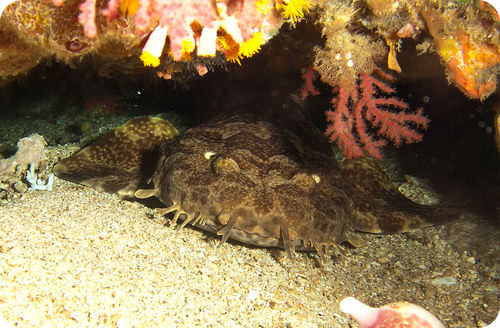10.5: Cartilaginous Fish
- Page ID
- 2929

How are these organisms different?
The two rays and the other fish pictured here do have a lot in common. They have streamlined bodies well suited for movement in the ocean. One difference, however, is their skeletons. The lone fish has a skeleton of bone. The rays have a skeleton of cartilage, and so they are known as cartilaginous fish.
Cartilaginous Fish
The 1,000 or so species of cartilaginous fish are subdivided into two subclasses: the first includes sharks, rays, and skates; the second includes chimaera, sometimes called ghost sharks. Fish from this group range in size from the dwarf lanternshark, at 6.3 inches, to the over 50-foot whale shark. Sharks obviously have jaws, as do the other cartilaginous fish. These fish evolved from the jawless fish. So why did fish eventually evolve to have jaws? Such an adaptation would allow fish to eat a much wider variety of food, including plants and other organisms.
Other characteristics of cartilaginous fish include:
- Paired fins.
- Paired nostrils.
- Scales.
- Two-chambered hearts.
- Skeletons made of cartilage rather than bone. Cartilage is supportive tissue that does not have as much calcium as bones, which makes bones rigid. Cartilage is softer and more flexible than bone.
Blood, Skin, and Teeth
Since they do not have bone marrow (as they have no bones), red blood cells are produced in the spleen, in special tissue around the reproductive organs, and in an organ called Leydig’s organ, only found in cartilaginous fishes. The tough skin of this group of fish is covered with placoid scales, which are hard scales formed from modified teeth. The scales are covered with a hard enamel. The hard covering and the way the scales are arranged, gives the fish skin rough, sandpaper-like feel. The function of these scales is for protection against predators.
The shape of sharks' teeth differ according to their diet. Species that feed on mollusks and crustaceans have dense flattened teeth for crushing, those that feed on fish have needle-like teeth for gripping, and those that feed on larger prey, such as mammals, have pointed lower teeth for gripping and triangular upper teeth with serrated edges for cutting. Sharks continually shed and replace their teeth, with some shedding as much as 35,000 teeth in a lifetime.
Superorders
The sharks, rays, and skates (which are similar to stingrays) are further broken into two superorders:
- Rays and skates.
- Sharks.
Sharks are some of the most frequently studied cartilaginous fish. Sharks are distinguished by such features as:
- The number of gill slits.
- The number and type of fins.
- The type of teeth.
- The size of their jaws.
- Body shape.
- Their activity at night.
- An elongated, toothed snout used for slashing the fish that they eat, as seen in sawsharks.
- Teeth used for grasping and crushing shellfish, a characteristic of bullhead sharks.
- A whisker-like organ named barbels that help sharks find food, a characteristic of carpet sharks.
- A long snout (or nose-like area), characteristic of groundsharks.
- Ovoviviparous reproduction, where the eggs develop inside the mother’s body after internal fertilization, and the young are born alive. This trait is characteristic of mackerel sharks. All sharks mate by internal fertilization. Some sharks then lay their eggs, others allow internal development.

Summary
- The cartilaginous fish are jawed fish with paired fins, paired nostrils, scales, two-chambered hearts, and skeletons made of cartilage rather than bone.
- Examples of the cartilaginous fish include sharks, rays, and skates.
Explore More
Chondrichthyes at http://www.youtube.com/watch?v=6i6wlz8V5x0 (13:15)
- How do Chondrichthyes differ from jawless fish (Agnatha)?
- How is the keel shape of their scales beneficial?
- What is the function of the cloaca in sharks?
- What is a notochord made of in sharks?
- How do sharks sense prey? Explain.
Review
- What are three features of cartilaginous fish?
- What are three examples of cartilaginous fish?
- What is Leydig’s organ?
- List three features that distinguish sharks.

